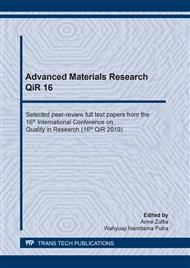p.227
p.233
p.238
p.248
p.257
p.265
p.272
p.278
p.285
Analysis of NiMoP/γ-Al2O3 Catalyst Preparation with Impregnation and Microwave Polyol Methods for Bio-Jet Production
Abstract:
Bio-Jet could be produced by the synthesis of vegetable oil through the hydrodeoxygenation, decarboxylation, decarbonization, and catalytic cracking process. Physical characteristics, activities, and selectivity of the catalyst used will determine the rate, conversion, and yield of the reaction that being carried out. This study aims to compare and obtain the best characteristics of NiMoP/γ-Al2O3 catalysts synthesized using two types of preparation, impregnation and microwave polyol methods, which will be used for bio-jet production. The impregnation method takes more than 24 hours for catalyst preparation, while microwave polyols that use microwaves can synthesize catalysts faster. Both catalysts have almost the same loading on the weight of the catalyst, which in the microwave polyol method has a more dispersed promotor and active site, although the crystallinity level is deficient and tends to be amorphous compared to the impregnation method with high crystallinity. In bio-jet synthesis reaction with operating conditions of 5% catalyst loading by comparison to Coconut Oil, 400°C, and 15 bar, the conversion, yield, and selectivity of catalyst impregnation were 91.705%, 47.639%, and 84.511%, while microwave polyol catalysts were 90.296%, 42.752%, and 82.517%, respectively. In conclusion, microwave polyol provides a more effective and efficient preparation method.
Info:
Periodical:
Pages:
257-264
Citation:
Online since:
July 2020
Keywords:
Price:
Сopyright:
© 2020 Trans Tech Publications Ltd. All Rights Reserved
Share:
Citation:


